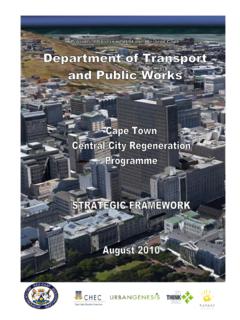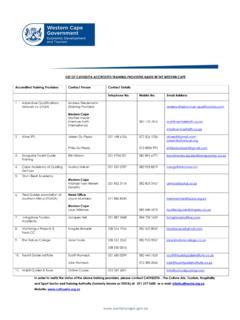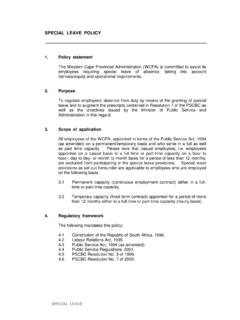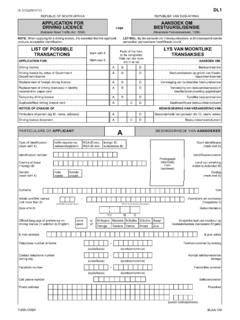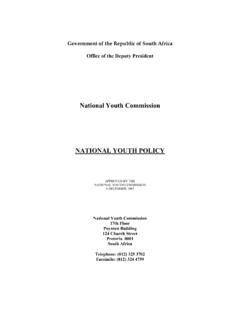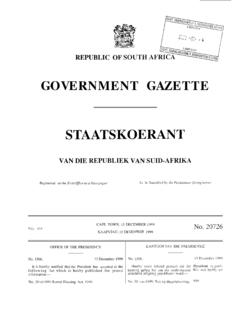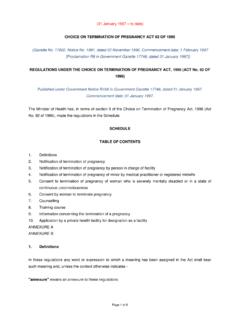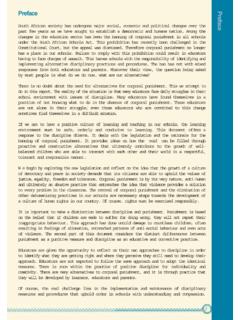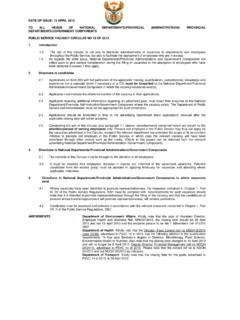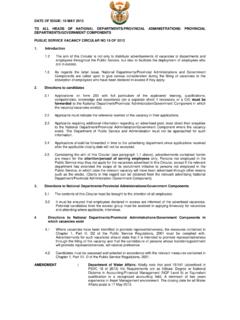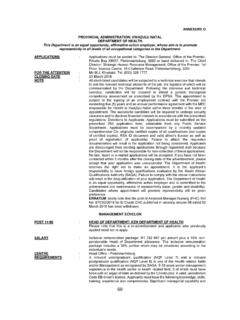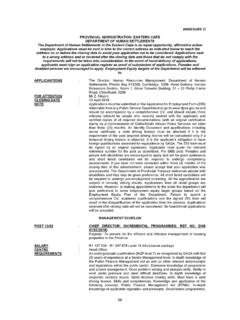Transcription of Provincial Administration Western Cape: …
1 Provincial Administration Western cape : department of health directorate : programme development Provincial POLICY, STANDARDISED GUIDELINES AND PROTOCOLS ON THE MANAGEMENT OF STERILISATION SERVICES directorate : programme development Sub- directorate : Reproductive health Enq: M Adamo Tel: (021)-4832684 CONTENTS Page 1. Preamble 3 2. Aims of the Policy 3 3. Management of Persons Capable of Consenting 4 Recommendations for Female Sterilisation 5 Guidelines for Male Sterilisation Services 9 4.
2 Management of persons incapable of consenting 11 Revised policy 11 Decentralised panels 11 Private Facilities 11 Aims of the panel 12 Application and assessment process 12 Constituting the panel 12 Responsibility of the convenor 13 Responsibility of the panel 13 Documentation 13 (a) Panel Assessment Documentation 13 (b) After the Sterilisation is Performed 13 (c) Failed Sterilisation 14 14 Availability of forms Public Awareness Campaign 14 Monitoring and Evaluation 14 Flow Chart: Application for Panel Assessment 15 Appendices: Pre-sterilisation Counselling Protocol Medical Eligibility Criteria (Addendum A-1 and A-2) Instructions to Clients Booking for Sterilisation Procedures (Addenda B-1 & B-2) Sterilisation Act, 1998 (Act No.)
3 44 of 1998) and Regulation R. 872 annexure A, Form I annexure B, Form II annexure C, Consent Form annexure D, Referral Report annexure E, List of Designated Facilities annexure F, Record of Sterilisations Performed annexure G, Notification of Pregnancy After Sterilisation 2 Provincial POLICY ON THE MANAGEMENT OF STERILSATION SERVICES department OF health : Western cape PROVINCE This Circular replaces Circulars H28/1999 and H29/1999 (Interim Policy Guidelines) dated 29 March 1999. 1. PREAMBLE The Sterilisation Act, 1998 (Act No. 44 of 1998, Government Gazette ) has reference. The Act provides an enabling and supportive legislative framework for sterilisation services in recognition of the individual s reproductive health rights enshrined in The Constitution of the Republic of South Africa, 1996 (Act 108 of 1996).
4 The National Contraceptive Policy Guidelines recommends that both male and female sterilisation services should be strengthened and expanded to be accessible and promoted to men and women who are certain that they do not wish to have more children. Validated international data suggests expected lifetime failure rates of: 1 in 200 following female sterilisation 1 in 2000 following male sterilisation There is no evidence that local failure rates exceed these levels. Lack of accurate data in recent years makes it impossible to confirm this. Over the past 10 years the total number of sterilisations in the Province has ranged between 9 500 and 11 000 per annum. A significant number of failures are therefore inevitable. Allegations of negligence should be completely defensible provided that: Adequate counselling, including clear explanation about failure risk and irreversibility has occurred and this is documented in the case records.
5 Informed consent has been explained and confirmed in writing. Adequately trained personnel using well-maintained equipment provide services. The operative procedure is clearly and comprehensively documented in writing. 2. AIMS OF THE POLICY To provide effective guidance for health care workers to: Promote and enhance equitable, accessible, cost-effective and user-friendly sterilisation services. Ensure clients receive a high quality service based on the best evidence currently available and thus minimise the risk of litigation. 3 Protect and promote personal human dignity and particularly for those individuals who are incapable of giving consent or are incompetent to give consent due to severe mental disability, by ensuring that decisions about sterilisation are made in a responsible and considerate manner.
6 3. MANAGEMENT OF PERSONS CAPABLE OF CONSENTING TO STERILISATION Any person 18 years or above who is capable of consenting may be sterilised at his or her request. A person capable of consenting may not be sterilised without his/her informed and written consent. Partner consent is not a legal requirement. However, individuals in a supportive relationship may choose to consult with each other. A person capable of consenting who requests a sterilisation must complete blocks A & B on the Request for a sterilisation procedure form ( annexure A, Form I, 004-9035) in addition to signing the regular consent form. That is, Form Code: 1904388: Consent To Sterilisation Procedure. Both these forms must remain in the client s facility folder. However, the client must receive adequate counselling in order to make an informed decision before the above-mentioned documentation is completed.
7 (See attached protocol for pre-sterilisation counselling). Each facility must submit a record of all the sterilisations performed at the facility on the attached annexure F form on a monthly basis, via the Regional health Information Component, to the Deputy Director: Reproductive health , PO Box 2060, cape Town, 8000. If no sterilisations were performed during a particular month, a Nil return is required. Note: Kindly do not forward the annexure A form to the Regional health information section or to the Provincial Head Office. Kindly ensure that all pregnancies occurring after sterilisation are reported on the attached prescribed form ( annexure G) and forwarded via the Regional health Information Component, to the Deputy Director: Reproductive health , PO Box 2060, cape Town, 8000.
8 RECOMMENDATIONS FOR FEMALE STERILISATION SERVICES 4A working group comprising of senior academic staff has compiled the following recommendations adapted from: Male and Female Sterilisation, Evidenced-based Clinical Guidelines No. 4, Published by the Royal College of O & G in April 1999. The aim of these recommendations is to inform managers and service providers so that patients receive a high quality service based on the best evidence currently available, and risk of litigation is minimised. INDICATIONS AND TIMING FOR STERILISATION There are no absolute contra-indications to sterilisation of women provided that they voluntarily request the procedure, receive adequate counselling, are capable of understanding and granting informed consent, and are not acting under duress (pressures from partner, family, healthcare or social welfare providers).
9 Provisions within the Sterilisation Act, Act 44 of 1998, cover cases where there is doubt about mental capacity to consent. (Refer to Management of Persons Incapable of Consenting - Point 4 of this document). Sterilisation is indicated when a woman is certain that she does not wish to conceive in the future and/or who s health would be at risk if she became pregnant and who chooses a permanent method of contraception. A recommendation to consider sterilisation by a healthcare professional should be part of a range of options offered. As a matter of good practice health professionals should concentrate on factual information, avoiding persuasion or any act that may be deemed coercive, however clear the advantage of their recommended option appears to be.
10 Tubal occlusion can be performed at any time in the menstrual cycle. Use of effective contraception before the procedure is advisable. A pregnancy test should be performed pre-operatively if pregnancy is suspected (missed or late menstruation). Care should be exercised in discussions with those taking decisions during pregnancy, particularly considering the outcome of this pregnancy. Tubal occlusion may be performed immediately postpartum or at the time of elective caesarean section if this has been requested, discussed and agreed upon in advance. Otherwise an interval (> 6 weeks) after delivery is recommended before surgery. Sterilisation at the time of emergency caesarean section or ectopic pregnancy is less than ideal, resulting in higher failure rate.
